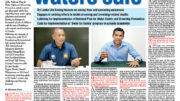Drowning Prevention Agencies come together for Phillipines first ever drowning prevention congress.
Through the joint efforts of Philippine Drowning Prevention Council (PDPC), Philippine Life Saving Society (PLS) and Philippine Sports Commission (PSC), the very first drowning prevention congress in the Philippines was held last Aug. 13-14 at De La Salle Santiago ” Zobel School, Ayala Alabang, Muntinlupa City.
The two-day event was attended by 555 participants from different organizations in the Philippines.
Representatives from active government organizations also graced the event: DepEd, TESDA, CHED, PSC, DOH, DILG, DOT, DENR, AFP/PN, DOTC/PCG, PIA, DND/NDCC as well as International Cooperators: UNICEF, WHO, ILS, RLSSA, SLSA, IDRC- B and TASC.
Day 1 was marked by simultaneous lectures conducted at Debbie Decena Auditorium followed by the first set of interactive pool demonstrations on Water Safety, Lifesaving Sports and Lifeguarding by PLS Bronze Medallion Awardees. The second set of demonstration activities continued on Day 2.
Mr. Arne Navarra, PDPC Convenor and PLS President, led the formal congress opening and presented the Philippine Drowning Prevention Plan 2010-2015. In his presentation, he underscored an estimate of 40, 000 increasing incidents of fatal drowning and near-drowning for all ages caused by disasters and daily living in the Philippines.
Drowning has been cited as epidemic, as it kills more than tuberculosis, malaria and dengue in the Philippines. Almost 300,000 Children drown every year in Asia and 1.5 Million will drown if no initiatives are done. Philippine Drowning Prevention Plan 2010-2015 is to reduce drowning incidence by 50% by the year 2015. Key priority areas have been identified in the plan: Water Safety Education, Drowning Prevention Research, Safe Aquatic Locations and Targeting Key Drowning Demographics.
Hon. Robert Bradley, President of International Life Saving in Asia Pacific, shared the strategy framework of Australian Water Safety Council and Royal Life Saving Society Australia in implementing drowning prevention efforts. The role of International Life Saving Federation was construed in the presentation of global drowning prevention initiatives.
Hon. Norman Farmer, General Manager for Strategic Development of Lifesaving Australia discussed the Drowning Prevention Framework applied on urban coastal areas, Lifesaving Sport, Tourism and Safety. He also introduced the Surf Lifesaving Australia and how community education and participation is promoted through information communication strategies.
Dr. Aminur Rahman, Director of International Drowning Research Centre in Bangladesh, presented their initiatives on drowning prevention in Bangladesh. He enforced that the key to preventing child injuries is through social intervention and education. He presented the idea of Safe Home, Safe School and Safe community. He also introduced about Swimsafe and how to evaluate the effectiveness of the program.
Col. Ernesto V. Ravina talked about the role of Philippine Navy in Disaster Risk Reduction and highlighted that mitigation and preparedness lessens the effects of natural and man-made disasters.
Explaining the importance of research in identifying and addressing drowning prevention issues, Dr. John Juliard Go, Technical Officer of WHO Philippines, stressed some areas of research that needs to be strengthened such as burden and risk factors in drowning prevention and evaluation of intervention studies.
A Special Address was also delivered by Hon. Gillian Akiko Thomson ” Guevarra, Commissioner of PSC.Akiko, who was an Olympian swimmer herself, emphasized the Role of Sports as a vehicle of delivering public awareness towards attaining a Culture on Drowning Prevention in the country.
All of the lectures given can be condensed into one common end ” build a strong cooperation among stakeholders ” to pursue a thriving collaboration with the resort owners, community, active government cooperators and international partners to reach the ultimate goal of a zero drowning incidents in the Philippines.



